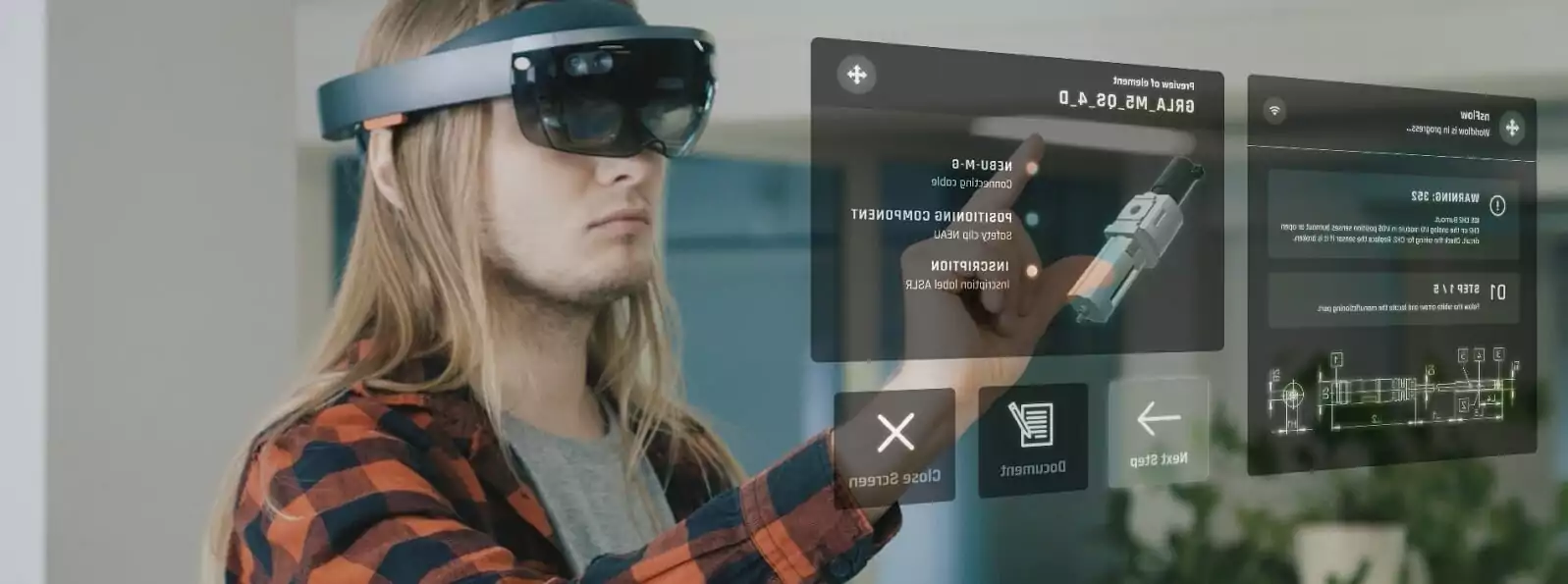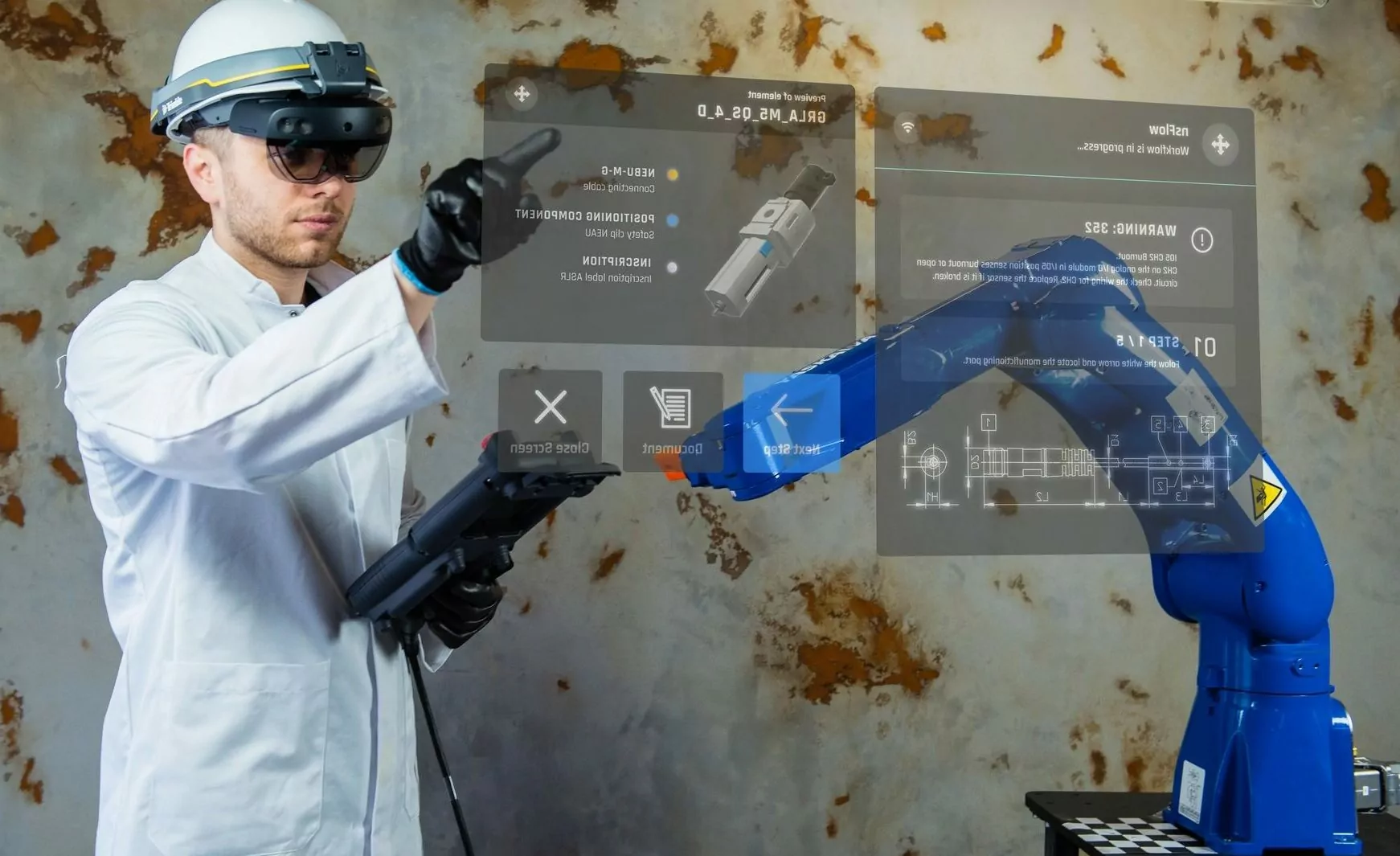There are many speculations around modern technologies and augmented reality (AR) in particular. Media often refers to it as an entertainment tool mostly, whereas its true potential isn’t so widely discussed.
In this blog post, we want to help you understand better what augmented reality is, what hardware it requires, what it can be applied for, as well as what are the existing adoption hurdles you should be aware of. With this information, we believe, you can make more reasonable decisions on whether to look closer at or stay away from AR.
What is augmented reality and how does it work?
Definition
Augmented reality (AR), one of the biggest buzzwords in tech these days, might sound like a science fiction term, but in fact, stands for a rather simple concept:
real world + relevant data = more effective way of using and interacting with the surrounding environment.
Augmented reality represents a layer of computer-generated content (text, graphics, sounds, virtual objects, haptic feedback) over the normal human field of view, that is perceived as a natural part of the environment, and allows interaction between these layers and a user. Since AR blurs the line between what’s real and what’s computer-generated, it is about to become a long-awaited link between the technology and the real world around us.
How it works?
To imagine this idea better we can compare AR basic idea of overlaying to how they put titles, banners or newsfeed over the video content on television. But in case of augmented reality, additional computer-generated data has many forms, can be highly personalized and change in accordance with the environment. Just like terminator vision:

Who can benefit from AR?
Enhancing the real surrounding with computer-generated data opens the whole new dimension of opportunities, finding its implementation far beyond entertainment and gaming industries (as many people still mistakenly think), transforming education, interior design, logistics, healthcare, industrial manufacture, construction etc.
Everyone from Pokemon fans to a first-day employee who doesn’t know how to add paper to the printer can benefit from the ability to add computer-generated graphics in their field of vision.
Augmented reality vs. mixed reality vs. virtual reality
Augmented reality is often referred to as “mixed reality” or “computer-mediated reality”. Since the difference between these terms hasn’t been drawn clearly enough yet, they are currently being used interchangeably with “augmented reality” dominating over the other two.
Sometimes, people confuse augmented reality with virtual reality despite quite a substantial difference between them. Whereas augmented reality alters your field of view, virtual reality replaces your entire field of view with the artificial digital environment. This makes the augmented reality much more practical than virtual reality.
AR hardware
Augmented reality requires several hardware elements: processor, display, sensors and input devices. Smartphones and tablets already have all these elements, and due to their wide use – drive the development of AR greatly.
Besides smartphones and tablets, there are devices, specifically developed for AR hand-free use, that vary depending on the technologies they are packed with. Wearable augmented reality hardware is especially beneficial, as they deliver the proper data at the proper moment and in the most-suited format, directly in users’ (learners, engineers, factory workers, logistics specialists…) line of sight, while leaving their hands free so they can perform their tasks with no interruption.
Smart glasses
Most popular AR devices are wearable computer glasses, so-called – smart glasses. The lens of such glasses work as a transparent display placed in front of the user’s’ eyes that allows seeing additional data without a need to look away from the current viewpoint.
Such glasses may be equipped with a camera, microphone, speakers, various sensors which allow deeper interaction with a device itself and augmented reality it creates. In simple terms, advanced smart glasses, in their properties and composition, aren’t different from wearing a PC on a head. Microsoft HoloLens, MagicLeap, Vuzix, Google Glass are among top smart glasses producers.
The AR wearables’ development kicks into high gear and promises many more devices to look forward. Those include Nreal and Lumus which have been presented at CES 2019.

How can businesses benefit from using AR?
Augmented reality is “going to change the way we use technology forever“ (as Tim Cook said) and bring tangible improvements to businesses in costs, efficiency, time and quality of their work. Here are the most prominent areas for AR adoption from a business point of view, in our opinion:
Knowledge transfer and staff training
knowledge share/cross-training/hands-on training
In times of high staff turnover, effective knowledge transfer is crucial. Augmented reality helps optimize and scale up this process. With AR new employees get clear descriptive guidance in front of their eyes, so that they can perform their tasks step by step straight away with no prior training or mentors around needed.
Similar to that, augmented reality enhances staff training by introducing demonstrative, interactive content and hands-on training, that users can easily access where and when they want, with no need to involve a teacher/trainer.
Manufacturing
standardization / workflow optimisation / crisis management / maintenance & repair / quality assurance / performance monitoring / knowledge transfer & training / stats & analytics
Augmented reality has a broad range of application in manufacturing: from creating step through workflows to optimise the performance, to tracking performance and gathering data for further analysis, to managing crisis situations. In case of breakdown, there is no need to disrupt the production line and wait for help to arrive. Workers can fix it following live instructions through AR smart glasses.
Machine design and industrial automation
design testing / interactive documentation / installation / maintenance / repair / knowledge transfer & training
Augmented reality allows testing equipment and vehicle design early on, eliminating the need to actually build a machine to check its ergonomics or correspondence to use environment. It also can be used for creating interactive documentation and hands-on tutorials for machine operators and maintenance teams.
Warehouse and logistics
hands-free communication & navigation / performance monitoring / shipping & returns / knowledge transfer & sharing / stats & analytics
Such AR features as real-time hands-free communication, navigation and quick status updates are very handy in logistics and supply chain.
Real-life examples of using AR by businesses
Augmented reality proved its maturity and has been adopted by many businesses: Ford, Bentley, BMW, DHL, IKEA, Caterpillar, CSIRO, ASTOR, HoloCrane – just to name a few.
DHL, the delivery company, use AR to improve order picking in logistics through their Vision Picking solution. IKEA allows customers to see how furniture will look at their homes before buying it. Car manufacturers, like Ford, use AR in car design. Caterpillar uses AR to provide customers with digital data and analytics regarding their machinery and improve operations. Boeing improves the manufacturing processes at factories with the help of AR.
Adoption hurdles
Augmented reality still has some adoption hurdles:
High costs of adoption
Verifying a use case, development itself, integration with external systems… – every stage is customized, and thus – expensive.
No common standards
among the diverse range of AR hardware and software lead to a need for custom design and integration of AR solutions.
Lack of flexibility
Modifications or adaptation of AR applications to new devices cost extra money (the same use case has to be implemented from scratch for each combination of AR hardware and software).
Poor business involvement
AR solutions are built by programmers with lack of use case understanding. This leads to getting not what the business needs in the end.
All these obstacles are also temporary and are easy to overcome by using a dedicated platform for AR applications development, such as nsFlow.
…We hope you find this useful. Sign up for further updates on this topic and many more.




